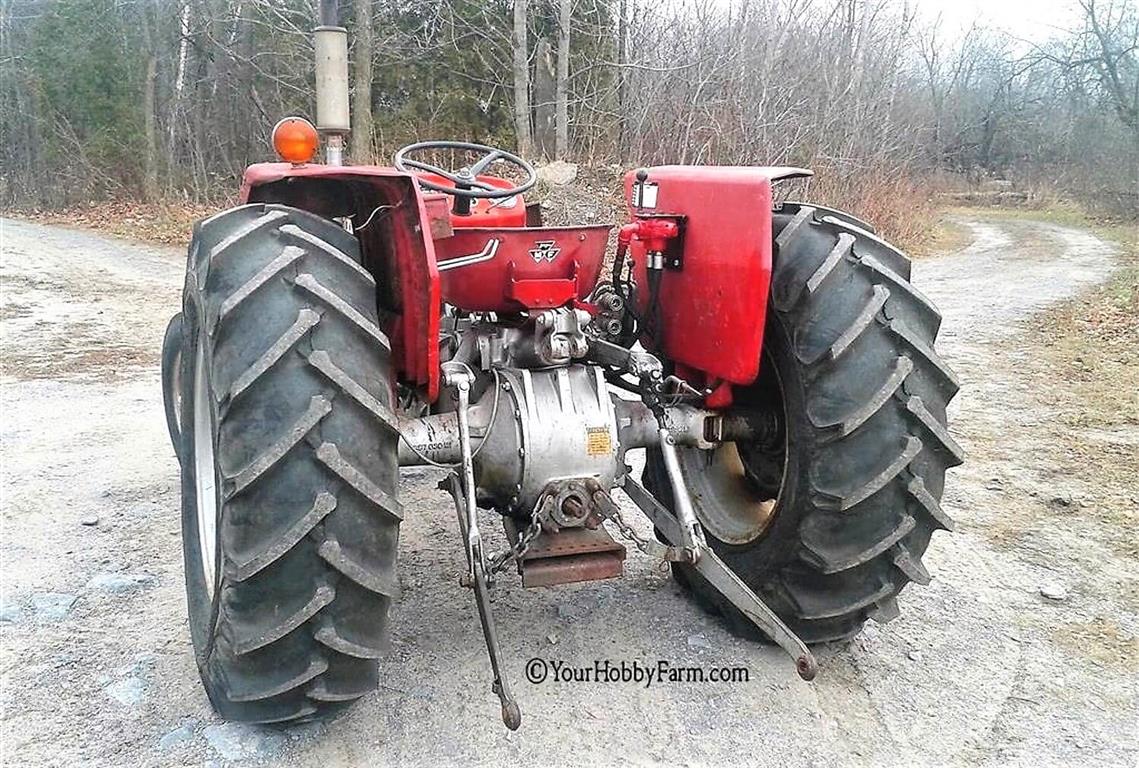
The linkage for the draft control mechanism is slightly different for the tractors in the two pictures. The ram is likely controlled mainly by a lever operable by the operator, with the draft control mechanism providing additional control. This ram raises and lowers the upper arms together. The main raising and lowering mechanism is likely an hydraulic ram that is internal to the tractor. Andy Dingley ( talk) 03:03, 15 January 2012 (UTC) Reply The crank and bevel gears at the top of the link leading to the lower right arm are an adjustment to raise/lower one of the lower arms in order to level the attached implement. The ram to raise and lower the two lower links is a purely mechanical screw jack, worked by a handle and bevel gear, just like a screw jack. No hydraulics on these old Fergies either. Whenever you want to use the drawbar you hitch it up, adjusting the lower arm rams to suit and the towball height will be back where you wanted it. You slack them off, set the towball height you want on your tractor, then clamp them up. Its two bars to the upper hitch point are adjustable, by clamped by bolts. If you look at the large version of the gold Fergie pic you shoudl see how the drawbar hitch implement works. Long moving links here weren't needed until multiple makers and models came along, and hitch heights started to vary over a wide range. The "upper arm" on these old Fergies is there, it's just very short. Aflafla1 ( talk) 02:40, 15 January 2012 (UTC) Reply įerguson TE, without implement Look at this image, of another Ferguson of similar vintage, but without an implement on the hitch. A mounted plow would likely use the third link. Instead of connecting the top tractor pivot point to one on the implement, two bars connect it to the implement's lower pivot point, which makes raising and lowering the lower arms (and thus the implement) impossible. But I still think that the top link is missing. And like you mentioned, the photo has value in showing the original design. Andy Dingley ( talk) 01:57, 15 January 2012 (UTC) Reply You may be correct for the original Ferguson implementation. There's also some value in showing a Ferguson tractor, with the original design of hitch.

There is nothing "missing" about this tractor or its hitch.

There aren't many implements where we can show the whole linkage in action without something behind hidden behind the implement, let alone having a tractor that's clean and painted in two colours. The two colours is quite a useful guide as to what's implement and what's hitch. First of all, it shows an implement that is actually using a three point hitch! The Case implement is on a drawbar instead. Aflafla1 ( talk) 01:27, 15 January 2012 (UTC) Reply The Ferguson photo is far better than the Case image. If it weren't for the text explanation, viewers would be totally confused. I've swapped photo positions because the Ferguson photo is so bad. Secondly the bottom links are holding a 'drawbar', and by its different color, it's the drawbar that's emphasized, not the three point hitch. First of all, the top link of the hitch is missing. The Ferguson photo is really a bad picture to illustrate a three point hitch. Cygnosis ( talk) 14:58, 20 October 2008 (UTC) Reply I couldn't find a conclusive reference as to the tractor hp at which the hitch category changes, so I noted it and included a range in the table. Charlesaf3 ( talk) 20:10, 5 July 2008 (UTC) Reply I started another entry called "Three point hitch" without the dash after not finding this in a search - the other article would be better changed to disambiguation I'm guessing - I've never seen "three-point" with the dash in usage, but it is probably more grammatically correct? I never remember the hyphenated words rules. The famous Grey Fergies could never have pulled a plough without it. After its invention tractors could be smaller and lighter with all the attendant cost benefits.

Prior to the 3 point linkage tractors had to be very heavily built otherwise their wheels would slip / spin when doing heavy work. Put another way it makes the tractor heavier in direct proportion to the amount of work being done. The other great benefit ( possibly the main one ) of the 3 point linkage is that it converts the drag of the implement behind the tractor into downward force on the tractors wheels. This article has been rated as Low-importance on the project's importance scale.

This article has been rated as Start-Class on the project's quality scale. Agriculture Wikipedia:WikiProject Agriculture Template:WikiProject Agriculture Agriculture articles If you would like to participate, please visit the project page, where you can join the discussion and see a list of open tasks. This article is within the scope of WikiProject Agriculture, a collaborative effort to improve the coverage of agriculture on Wikipedia.


 0 kommentar(er)
0 kommentar(er)
